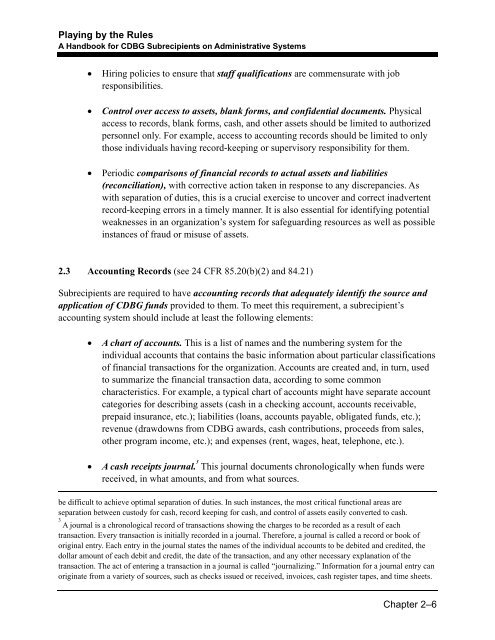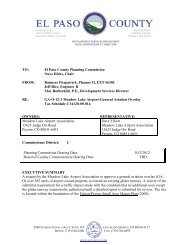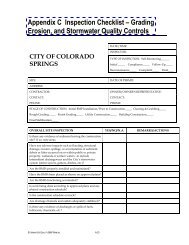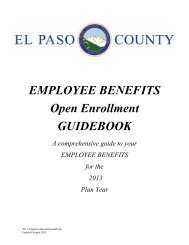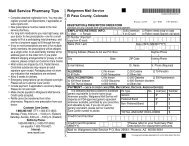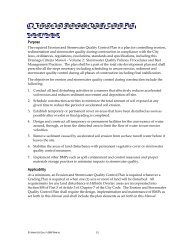Playing by the Rules: A Handbook for CDBG ... - City of El Cajon
Playing by the Rules: A Handbook for CDBG ... - City of El Cajon
Playing by the Rules: A Handbook for CDBG ... - City of El Cajon
Create successful ePaper yourself
Turn your PDF publications into a flip-book with our unique Google optimized e-Paper software.
<strong>Playing</strong> <strong>by</strong> <strong>the</strong> <strong>Rules</strong><br />
A <strong>Handbook</strong> <strong>for</strong> <strong>CDBG</strong> Subrecipients on Administrative Systems<br />
• Hiring policies to ensure that staff qualifications are commensurate with job<br />
responsibilities.<br />
• Control over access to assets, blank <strong>for</strong>ms, and confidential documents. Physical<br />
access to records, blank <strong>for</strong>ms, cash, and o<strong>the</strong>r assets should be limited to authorized<br />
personnel only. For example, access to accounting records should be limited to only<br />
those individuals having record-keeping or supervisory responsibility <strong>for</strong> <strong>the</strong>m.<br />
• Periodic comparisons <strong>of</strong> financial records to actual assets and liabilities<br />
(reconciliation), with corrective action taken in response to any discrepancies. As<br />
with separation <strong>of</strong> duties, this is a crucial exercise to uncover and correct inadvertent<br />
record-keeping errors in a timely manner. It is also essential <strong>for</strong> identifying potential<br />
weaknesses in an organization’s system <strong>for</strong> safeguarding resources as well as possible<br />
instances <strong>of</strong> fraud or misuse <strong>of</strong> assets.<br />
2.3 Accounting Records (see 24 CFR 85.20(b)(2) and 84.21)<br />
Subrecipients are required to have accounting records that adequately identify <strong>the</strong> source and<br />
application <strong>of</strong> <strong>CDBG</strong> funds provided to <strong>the</strong>m. To meet this requirement, a subrecipient’s<br />
accounting system should include at least <strong>the</strong> following elements:<br />
• A chart <strong>of</strong> accounts. This is a list <strong>of</strong> names and <strong>the</strong> numbering system <strong>for</strong> <strong>the</strong><br />
individual accounts that contains <strong>the</strong> basic in<strong>for</strong>mation about particular classifications<br />
<strong>of</strong> financial transactions <strong>for</strong> <strong>the</strong> organization. Accounts are created and, in turn, used<br />
to summarize <strong>the</strong> financial transaction data, according to some common<br />
characteristics. For example, a typical chart <strong>of</strong> accounts might have separate account<br />
categories <strong>for</strong> describing assets (cash in a checking account, accounts receivable,<br />
prepaid insurance, etc.); liabilities (loans, accounts payable, obligated funds, etc.);<br />
revenue (drawdowns from <strong>CDBG</strong> awards, cash contributions, proceeds from sales,<br />
o<strong>the</strong>r program income, etc.); and expenses (rent, wages, heat, telephone, etc.).<br />
• A cash receipts journal. 3 This journal documents chronologically when funds were<br />
received, in what amounts, and from what sources.<br />
be difficult to achieve optimal separation <strong>of</strong> duties. In such instances, <strong>the</strong> most critical functional areas are<br />
separation between custody <strong>for</strong> cash, record keeping <strong>for</strong> cash, and control <strong>of</strong> assets easily converted to cash.<br />
3<br />
A journal is a chronological record <strong>of</strong> transactions showing <strong>the</strong> charges to be recorded as a result <strong>of</strong> each<br />
transaction. Every transaction is initially recorded in a journal. There<strong>for</strong>e, a journal is called a record or book <strong>of</strong><br />
original entry. Each entry in <strong>the</strong> journal states <strong>the</strong> names <strong>of</strong> <strong>the</strong> individual accounts to be debited and credited, <strong>the</strong><br />
dollar amount <strong>of</strong> each debit and credit, <strong>the</strong> date <strong>of</strong> <strong>the</strong> transaction, and any o<strong>the</strong>r necessary explanation <strong>of</strong> <strong>the</strong><br />
transaction. The act <strong>of</strong> entering a transaction in a journal is called “journalizing.” In<strong>for</strong>mation <strong>for</strong> a journal entry can<br />
originate from a variety <strong>of</strong> sources, such as checks issued or received, invoices, cash register tapes, and time sheets.<br />
Chapter 2–6


